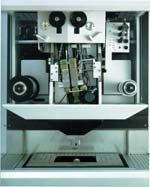Machining To Sub-Micron Accuracy--With EDM
Electrical discharge machining (EDM) has a long tradition of being one of the most pioneering of metalworking technologies. Shops with EDM learned (by necessity) to deal with unattended operation long before it became feasible elsewhere.
Electrical discharge machining (EDM) has a long tradition of being one of the most pioneering of metalworking technologies. Shops with EDM learned (by necessity) to deal with unattended operation long before it became feasible elsewhere. The integrated tooling systems developed for EDM inspired similar applications in general metalworking. The power supplies required for EDM have provided truly closed-loop control of the metal removal process, a capability unmatched in chip-making applications. Robotic cells integrating EDM with milling machines, measurement systems and other processes are some of the most advanced applications of automation to be found in industry—a fact that is all the more remarkable given that the majority of these cells have been installed in tool and die shops, job shops and mold shops, which typically have under 50 employees.
EDM continues to establish new frontiers, going where no other metalworking process has been before. A recent example of this trailblazing is the latest wire EDM from Agie of Losone, Switzerland (in the United States, Agie USA Ltd. in Davidson, North Carolina). This system, the Agiecut Vertex, is designed to cut workpieces with a dimensional accuracy of ±0.5 µm (half a micron—0.00002 inch) or below. Surface finish attainable is said to be in the range of 0.05µm Ra.
According to its developers, this system opens up new possibilities for manufacturing parts in the electronics, medical and watch-making industries as well as for the production of micro-mechanical parts. New generations of computer chips, for example, are predicted to call for lead frame stamping dies that can produce parts twice as small as current requirements and produce them twice as quickly. Likewise, the medical industry is looking for surgical tools that can function when delivered by catheter inside a blood vessel deep within the human body. Such applications represent a growing market for a machine tool with sub-micron precision.
The design and construction of the new machine tool represent a radical departure from other Agiecut models. The Vertex is mechanically similar to a high-end measuring machine. The design is based on a number of key principles: Keep axis motion as close to the EDM work zone as possible. Keep sources of heat and vibration as far away from the work zone as possible. Keep heat sources insulated or neutralize any heat with water or air cooling systems. Keep the whole unit as compact as possible to minimize influences from the outside environment. All axes are monitored with both glass scales and linear encoders having a resolution of 0.1 µm.
The other major innovation embodied in the machine is a wire feed unit that features two spools of wire for wires of different diameters. Wires from 0.02 to 0.20 mm (0.008 to 0.0008 inch) in diameter can be used. For contrast, the wire most commonly used on the typical wire EDM is 0.008, 0.010 or 0.012 inch in diameter. The system can be programmed to cut with one size wire and then automatically switch to the wire in the other spool. For example, a corner first cut with the 0.20 mm wire could be recut with the 0.02 mm wire to create a much smaller corner radius. The small wire could also be used for skimcuts to achieve an extremely fine surface finish. Rethreading is automatic for any size wire in the range.
According to Agie representatives, the use of wires this small required new sensors for process monitoring and a new power generator for greater sensitivity and responsiveness. The machine tool, wire feed unit, control unit and power supply are all contained within the unit's enclosure.
There is no indication that this development bumps up against the laws of physics, making even greater precision unattainable with the EDM process. However, it does seem that the practical extreme for precision in wire EDM has been established, at least for the foreseeable future.
Related Content
Choosing Your Carbide Grade: A Guide
Without an international standard for designating carbide grades or application ranges, users must rely on relative judgments and background knowledge for success.
Read MoreHow to Reduce Cycle Times by 70% and More on Your Existing CNCs and Dramatically Improve Tool Life Too
By employing advanced high efficiency milling techniques for the entire machining routine, SolidCAM’s iMachining technology can drastically reduce cycle times while vastly improving tool life compared to traditional milling.
Read MoreChoosing The Right Grinding Wheel
Understanding grinding wheel fundamentals will help you choose the right wheel for the job.
Read MoreWatchmaking: A Machinist’s View
Old-world craftsmanship combines with precision machining on a vertical machining center and Swiss-type lathe to produce some of the only U.S.-made mechanical wristwatch movements.
Read MoreRead Next
3 Mistakes That Cause CNC Programs to Fail
Despite enhancements to manufacturing technology, there are still issues today that can cause programs to fail. These failures can cause lost time, scrapped parts, damaged machines and even injured operators.
Read MoreThe Cut Scene: The Finer Details of Large-Format Machining
Small details and features can have an outsized impact on large parts, such as Barbco’s collapsible utility drill head.
Read More










.jpg;maxWidth=300;quality=90)








.png;maxWidth=300;quality=90)








